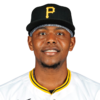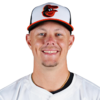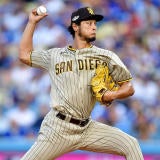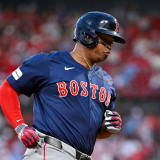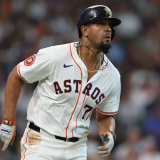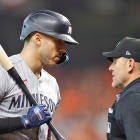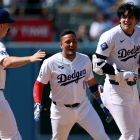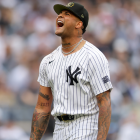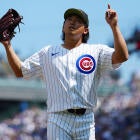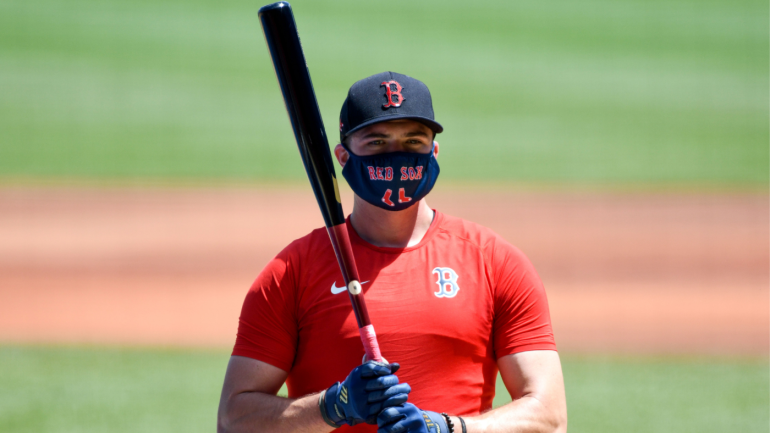
With Major League Baseball's regular season nearly over, we decided it would be worthwhile to check in on some notable prospects who we haven't yet touched upon.
Today, that means highlighting five young positional players: third basemen Alec Bohm (Phillies) and Ke'Bryan Hayes (Pirates), first baseman Bobby Dalbec (Red Sox), left fielder Ryan Mountcastle (Orioles), and outfielder Leody Taveras (Rangers).
The Phillies drafted Alec Bohm third overall in 2018 based on his offensive promise. He hasn't disappointed in his first 24 games, hitting .291/.344/.419 (102 OPS+) with seven extra-base hits.
Bohm employs a disciplined, though not passive approach at the dish. He doesn't expand the plate often, but he's more than willing to swing the bat if he gets a pitch to his liking within the zone. That's a formula that has worked well for Freddie Freeman, among well-regarded hitters. Bohm's power output has been a question dating back to his collegiate days. He's strong and he hits the ball hard (his average exit velocity is 91 mph, several ticks above par), yet he's more of an up-the-middle hitter than a pull-happy slugger. His hardest-struck balls have been to the right-center alley, and he and the Phillies might have to decide whether they'd prefer for him to keep the additional points of batting average in favor of whatever slugging gains could be had.
Bohm lacks the same appeal on the defensive side of things; he's listed at 6-foot-5, and he moves like it. He has the hands and the arm strength for the hot corner, but he's not quick and his throwing motion can get long. Bohm's future would likely take place at first base for any other club. The Phillies already have Rhys Hoskins occupying the cold corner, so Bohm might have to settle for DH, or perhaps try his hand in an outfield corner, where his substandard wheels would likely hinder his range and keep him on the wrong side of average.
Wherever Bohm plays, or doesn't play, he projects as a middle-of-the-order hitter who contributes in each of the triple-slash categories.
The Red Sox promoted Bobby Dalbec to the majors and traded Mitch Moreland to the Padres at the deadline. Though Dalbec is regarded as a quality third baseman, Boston has had him playing first base out of deference to Rafael Devers. He has looked good there, to no surprise.
Dalbec hasn't looked as good at the plate. He has big-time raw power, the kind that allows him to leave the ballpark to all fields, even when he's late or otherwise has a suboptimal point of contact. Unfortunately, he also has big-time strikeout issues stemming from his patient approach and his tendency to swing-and-miss. He fanned in 16 of his first 35 plate appearances in the Show, and he has since started to tinker with his mechanics, raising his hand slot and alternating between a leg kick and a toe tap as he attempts to improve his timing.
Dalbec, who turned 25 years old in June, should be afforded the opportunity to play the rest of the season as the Red Sox attempt to figure out what they have here. The upshot is that he becomes a three-true-outcomes slugger who can defend either corner-infield position.
If Ke'Bryan Hayes isn't Bohm's inverse, he's close enough to it for this paragraph construct to work. Whereas Bohm's defense can be summed up by pointing at his offensive numbers, Hayes is a talented third baseman whose stick could play lighter than what is ideal for a corner infielder. You wouldn't know that last part based on his first week in the majors.
In six games, Hayes has hit .381/.435/.762 with a homer, two triples, a double, and an average exit velocity of 97 mph. That's quite the introduction. The longstanding concern with his bat has been his lackluster power output. He set a new career-high last season in Triple-A by homering 10 times, and that, of course, coincided with the introduction of the rabbit ball. Hayes has made a habit out of walking and putting the ball in play and he has above-average wheels; it's just always worth wondering how a low-wattage hitter is going to be received by big-league pitching.
At least we can confidently write that Hayes will be well-received by his own pitching staff because of his defensive exploits. He's smooth and capable at the hot corner, with a strong arm, soft hands, and everything else that one needs to be a perennial Gold Glove threat.
Ryan Mountcastle probably deserved to be in the majors last year, when he hit .311/.344/.527 with 25 home runs in Triple-A. The Orioles opted against promoting him until this August, allowing him more time to work on his main weaknesses: his eye and his position.
Part of Mountcastle's education involved studying Mike Trout's swing decisions. Whether or not that proved helpful is anyone's guess, but he is walking in more than nine percent of his plate appearances thus far, a few steps beyond his minor-league career-high (6.1 percent). He's also hitting .339/.397/.607 with four home runs in those 16 games. He's shown off his bat speed, pop, and ability to hit pitches that many hitters wouldn't swing at, let alone be able to tame.
The funny thing is that Mountcastle isn't demonstrating monk-like patience at the dish; he's offered at nearly 60 percent of the pitches he's seen, and is expanding the zone more frequently than the average hitter. Are you sure Trout done it this way? Well, no, but whatever works.
The other notable development in Mountcastle's game is that he's now a left fielder. He wasn't going to cut it at third base, and the Orioles weren't content to settle for first base. Mountcastle is still learning the nuanced aspects of the position -- he's had some close calls with Baltimore's infielders that would be resolved with better communication -- but he looks more capable than might be expected given his limited experience. (It doesn't hurt that the Orioles are playing him deeper than most left fielders, reducing the times he has to go back on balls.)
Mountcastle's bat was always going to determine his value. Nothing has changed in that regard.
Leody Taveras is, in a sense, Hayes if Hayes were a switch-hitter who played center field. That is to say: his defensive value is undeniable while his offense remains a point of contention.
Taveras has above-average speed and he gets good jumps on the ball, allowing him a large catch radius. He also has a strong arm, giving him the potential to record outs on batted balls that result in hits, depending on how lucky baserunners are feeling on any given play. The Rangers are so far leveraging him by playing him relatively shallow, versus the positional norm.
Taveras' efforts at the plate haven't been as easy to embrace. He's batted .220/.316/.380 in 57 plate appearances while functioning largely as a low-ball hitter. Your mileage may vary on Statcast's expected metrics, but they indicate that he should have had more success so far based on his exit velocity and launch angle, both of which are roughly average. Taveras should be able to steal bases (though his efficiency could use work) and there's long been an expectation that he'll hit for more power as he matures. He just turned 22, so there's still time to grow.
In a perfect world, Taveras hits enough to be a dynamic two-way contributor; in this world, it seems more likely that he's a speed-and-D outfielder who settles in as a second-division starter.











